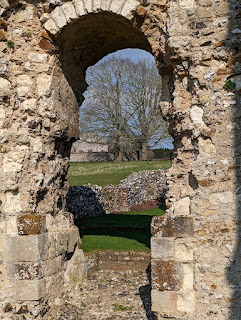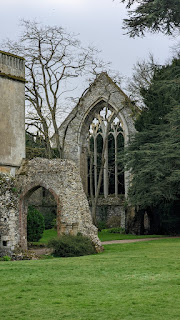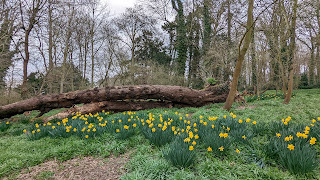I was in Norfolk today with my friends Rebecca and Stuart ruined Abbeys and Priories.
First stop was Castle Acre Priory.
The priory dates back to 1090, it was the home of the first Cluniac order of monks to England. The priory was originally (1089) located within the walls of the nearby Castle but moved to the current site in 1090. It was dissolved in 1537. There was a fine parish church so alas the priory church didn't survive.
The priory has some fine priors lodgings which we didn't get to. Not sure why!!
I have never been to Creake Abbey. It was a free property so I new it wouldn't be extensive..
Creake Abbey probably had its origins in 1206 when Sir Robert and Lady Alice de Nerford established the small chapel of St Mary of the Meadows at Lingerescroft, bordering the tiny River Burn.
In 1217 they founded the Hospital of St Bartholomew there and when the establishment embraced the rule of St Augustine the chapel became a priory, prompting extensions to both the church and priory buildings.
In 1225 Henry III elevated the priory to abbey status and it benefited from many generous donations, but a fire in around 1484 left the abbot at Creake petitioning the king for help.
Despite gifts from Richard III and a bequest by Sir William Calthorpe, the nave and parts of the transepts were demolished, reducing the house once more to a modest church.
Early in the 16th century the abbey was devastated by the plague and when the abbot died, alone, on 12 December 1506, the abbey reverted to the Crown.
In the 1530's Margaret Beaufort used the Creake estates to endow her new foundation of Christ's College Cambridge.
And so to Walsingham. We ate lunch outside :)
The reason for going was Walsingham Abbey. In the middle ages it was a priory but between the late 17th and early 19th century the house on the site, originally the Prior’s lodging, was enlarged into a mansion, and became known as ‘The Abbey’.
Walsingham Priory had its origins in the time of Edward the Confessor, the chapel of Our Lady of Walsingham was confirmed to the Augustinian Canons a century later and enclosed within the priory. Walsingham is the site of the reputed Marian apparitions to Richeldis de Faverches in 1061. The Virgin Mary is therefore venerated at the site with the title of Our Lady of Walsingham.
From the first this shrine of Our Lady was a famous place of pilgrimage. Hither came the faithful from all parts of England and from the continent until the destruction of the priory by Henry VIII in 1538. To this day the main road of the pilgrims through Newmarket, Brandon, and Fakenham is still called the Palmers' Way. Many were the gifts of lands, rents, and churches to the canons of Walsingham, and many the miracles wrought at Our Lady's shrine.
Henry III, Edward I, Edward II, Henry VI Henry VII and Henry VIII all came there on pilgrimage as did Erasmus.
As travelling abroad became more difficult during the time of the Crusades, Walsingham became a place of pilgrimage, ranking alongside Jerusalem, Rome and Santiago da Compostela.
Today little of the ruins remain although the Great East Window is impressive. The grounds contain a medieval bridge holy wells and are a lovely walk.
Little Walsingham Church.
Father Alfred Hope Patten SSC, appointed as the Church of England Vicar of Walsingham in 1921, ignited Anglican interest in the pre-Reformation pilgrimage. It was his idea to create a new statue of Our Lady of Walsingham based on the image depicted on the seal of the medieval priory. In 1922 the statue was set up in the Parish Church of St Mary and regular pilgrimage devotion followed. From the first night that the statue was placed there, people gathered around it to pray, asking Mary to join her prayers with theirs.
The shrine church was substantially extended in the 1960s. The church has a holy well known for its healing properties; the act of receiving water from the holy well is often accompanied by the laying on of hands and anointing. Water from the well is often taken home by the faithful and distributed to their family, friends and parishioners.
The grounds include the shrine church, gardens, several chapels, a refectory, a café, a shrine shop, a visitors' centre, the Pilgrim Hall, an orangery, the College (home to priests-associate when in residence), and a large number of different residential blocks for the accommodation of resident pilgrims..

















































































2 comments:
What a great post Pete and what a super day out. Your photos are superb and so interesting to read all the history. I would love to visit Walsingham perhaps one day.....
thanks RR... it was a fascinating place. Probably best in Spring. Meant to be good for snow drops
Post a Comment